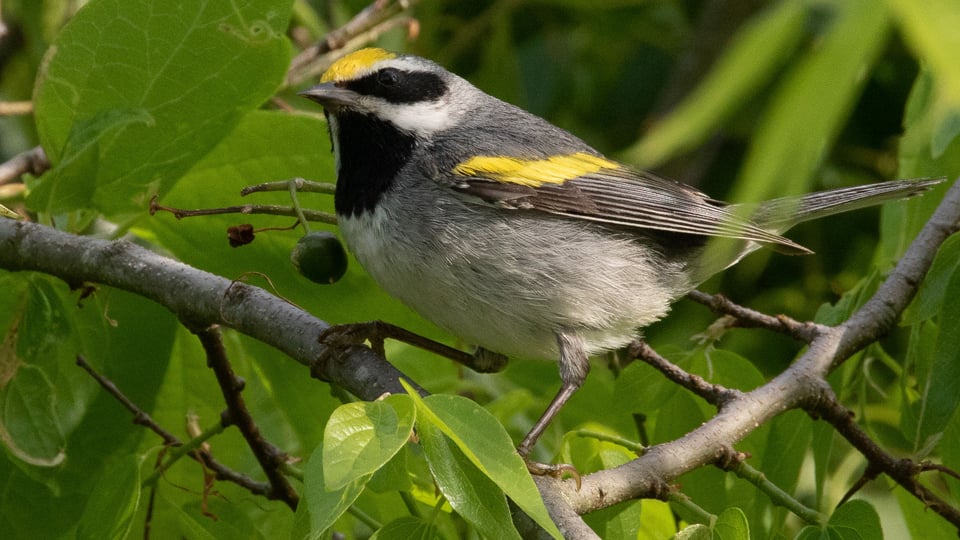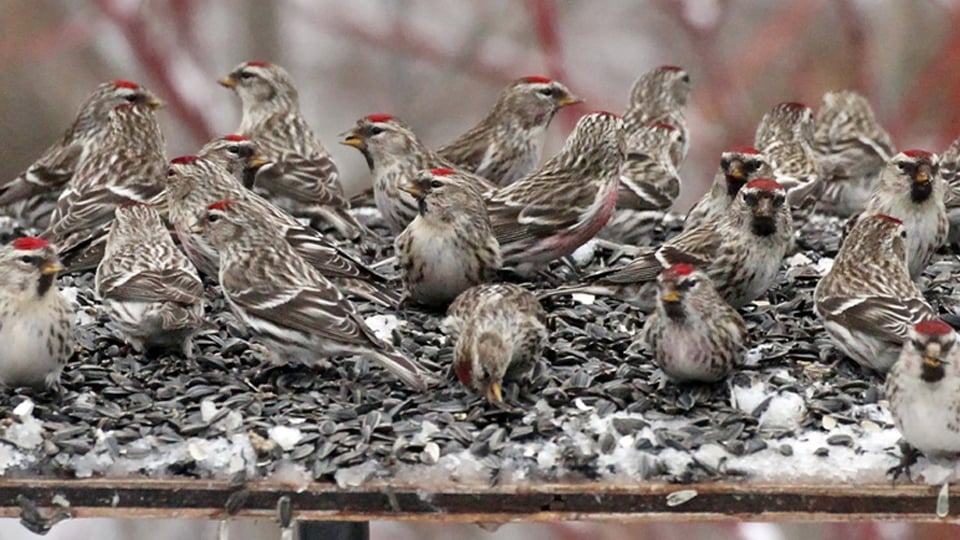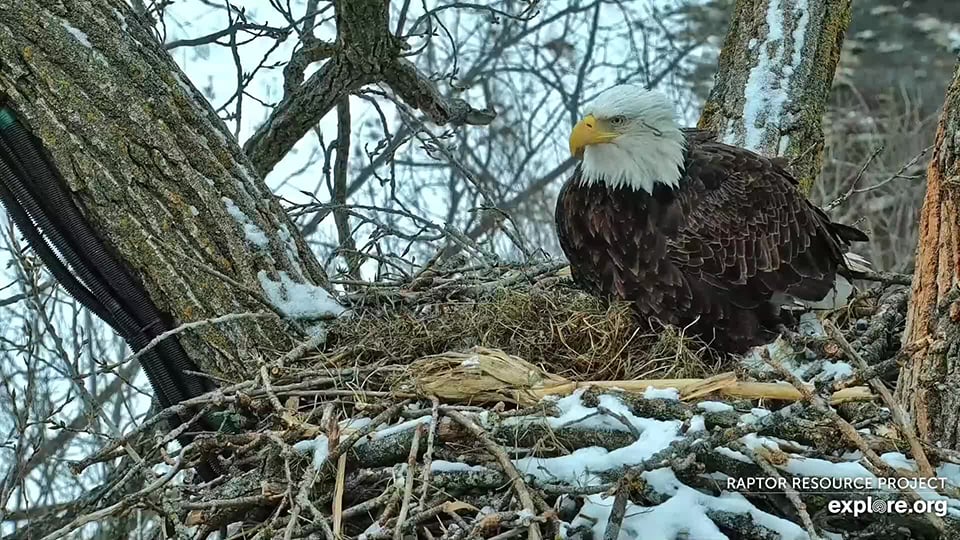Can birds detect severe weather? I’m watching the birds at my feeder as a major snowstorm rolls in. American Golden Finches, Dark-Eyed Juncos, Black-Capped Chickadees, and White-Breasted Nuthatches are decimating my seed feeder, while our resident Downy, Hairy, Red-Bellied, and Pileated Woodpeckers clean out my suet feeder. The feeder action started yesterday. Did our birds know a major storm was on the way?
While birds can’t predict long-range weather patterns, they have at least two ways to detect and prepare for incoming storms. Many animals can hear infrasound – sound waves with a frequency below the lower limit of human audibility (20 Hz or lower) – and birds have a special middle-ear receptor that senses changes in barometric pressure. Both of these things let them know that storms are coming!
I hear a storm coming: infrasound weather detection

Golden-winged Warbler. Photo credit Bettina Arrigoni
We use sophisticated sensors and powerful computers to predict storms and detect tornados several minutes before they touch down, but birds have us beat when it comes to short-term storm detection. In 2014, five radio-tagged Golden-winged Warblers undertook an evacuation migration from eastern Tennessee two days before a massive storm system spawned 84 tornadoes and killed 35 people across the southeastern United States. The warblers – tiny little birds! – traveled over 1500 kilometers in five days to avoid the deadly storms, flying south to the Florida coast days before human forecasters issued their first warnings. They returned to their mountain breeding grounds once the storm system passed.
Researchers initially reasoned that subtle changes in weather—atmospheric pressure, temperature, wind speed, cloud cover, or rainfall—signaled the impending disaster. Yet when they checked weather records, none of these factors fluctuated significantly prior to the storm. The infrasound produced by surf, tides, and wind helps guide birds on migration. Perhaps storm-generated infrasound let the warblers know it was time to leave.
My ears popped: barometric weather detection
Birds have a special middle-ear receptor called the Vitali organ that senses changes in barometric pressure. This allows them to maintain elevation even when the ground isn’t visible – think of foggy days, night migrations, or flight above the clouds – and detect declining barometric pressures that signal approaching storm fronts.

Redpolls at a feeder. These birds will eat you out of house and home! Photo credit Ryan Brady.
A study conducted by Western University’s Advanced Facility for avian research found that changes in barometric pressure helped birds make decisions about everything from flight to feeding. When a bird wakes up, it generally preens its feathers and gets a handle on the day (caw-fee, anyone?) before eating breakfast. When researchers dropped the barometric pressure to simulate an approaching winter storm, the birds skipped their morning routine and went straight to packing in the seeds – something I’ve been watching at my feeders since yesterday.
What do eagles do?
So how will Mr. North, DNF, HM, HD, Mom, DM2, and wintering migratory eagles weather the coming storm and bitterly cold weather? Depending on the situation, they can maximize energy gain by foraging in groups, gorging food, and increasing the assimilation of ingested food energy. They can minimize energy loss by reducing activity, seeking protective microclimates, and lowering their nocturnal body temperature. In short, the eagles we watch will keep warm by deploying their special superpower: using the least amount of energy to get the most amount of food.
Group Foraging and Changes in Behavior

January 14, 2021: Eagles at Lock and Dam Seven on Lake Onalaska, Mississippi River
All bald eagles reduce activity and seek shelter during periods of extreme cold. Non-territorial eagles also forage in groups and roost communally to help conserve energy.
- When one eagle finds food, every eagle finds food. Non-territorial bald eagles often forage in groups, which lets them find more food with less work than hunting alone. They also steal prey from other eagles, which can be more energy efficient than catching it themselves. Why go fishing when someone else can do it for you?
- Eat it before someone else gets it! When eagles eat more food than they can digest, they store the excess in their crops for later. Gorging loads calories quickly and reduces the opportunity for food theft.
- It’s too cold to do anything but perch! Eagles are less active during periods of extreme cold. Inactivity reduces an eagle’s energy consumption and slows its metabolism.
- Stay out of the wind. Eagles reduce wind exposure and slow energy radiation by sheltering in thick brush, bluff pockets, on the lee side of branches, and in coniferous trees: places where wind won’t wick their body heat away.
Physical Adaptations

December 20, 2022: Stay warm, everyone! HM’s stylish winter jacket is fluffed up against the cold.
Physical adaptations help eagles stay warm and incubate their eggs in subzero temperatures.
- An eagle’s 7,000 feathers keep it warm and dry. Stiff exterior vane feathers zip together over fluffy down feathers: an overcoat that sheds water and keeps heat from escaping. Down feathers trap layers of air next to an eagle’s body, where it warms quickly. An eagle can change how much air is trapped by moving its feathers to create more or less air space.
- A bald eagle controls its core body temperature with counter-current heat exchange. Warm arterial blood flowing from an eagle’s core into its feet passes cool venous blood flowing back. This warms the blood flowing into its core and cools the blood flowing into its feet. The cooler blood is warm enough to prevent frostbite and reduces the temperature gradient between its insides and its outsides, which prevents excessive heat loss through its feet.
- An eagle’s leg muscles are tucked up under its feathers, near the warm center of its body. It has very few soft tissues in its long legs and feet, which are wrapped in thick, scaly skin that protects them from the cold. If its feet do get cold, it will tuck them beneath its feathers.
- Cold weather causes changes in blood flow. Less blood flows to an eagle’s skin and extremities, making more blood available for visceral organs like the stomach. This helps eagles reduce energy radiation and increase the assimilation of ingested food energy at a time when every calorie is crucial.
- At night, bald eagles lower their body temperatures by about 1.8 degrees. This reduces the temperature gradient between their body and the environment, letting them burn fewer calories to stay warm.
The weather outside is frightful, but our eagles are delightful – and well-prepared for the coming winter weather!
Did You Know?
Animals use infrasound to communicate. Whales, elephants, hippopotamuses, rhinoceroses, giraffes, okapis, peacocks, and alligators all use infrasound to communicate over a distance. Elephants also produce infrasound waves that travel through solid ground using their feet. These calls may be used to coordinate the movement of herds and allow mating elephants to find each other.
Biologist Lyall Watson described a moving encounter between the last remaining Knysna elephant and a whale on the shores of South Africa. He wrote: “She was here because she no longer had anyone to talk to in the forest. She was standing here on the edge of the ocean because it was the next, nearest, and most powerful source of infrasound. The under-rumble of the surf would have been well within her range, a soothing balm for an animal used to being surrounded by low and comforting frequencies, by the lifesounds of a herd, and now this was the next-best thing…
“But just as I was about to be consumed by helpless sorrow, something even more extraordinary took place. The throbbing was back in the air. I could feel it and I began to understand why. The blue whale was on the surface again, pointed inshore, resting, her blowhole clearly visible. The Matriarch was here for a whale! The largest animal in the ocean and the largest living land animal were no more than a hundred yards apart and I was convinced they were communicating! In infrasound, in concert, sharing big brains and long lives, understanding the pain of high investment in a few precious offspring, aware of the importance and the pleasure of complex sociality, these rare and lovely great ladies were commiserating over the back fence of this rocky Cape shore, woman to woman, matriarch to matriarch, almost the last of their kind…”
I’m not sure which book that magnificent passage came from, but here’s a list of Lyall’s books: https://www.goodreads.com/author/list/8518.Lyall_Watson
Infrasound may also guide birds on migration. How do birds like Arctic Terns and Bar-Tailed Godwits navigate vast featureless stretches of the Pacific and Southern Oceans? Infrasound is ubiquitous in the marine environment and seabirds might use it to guide them to and from their breeding grounds as they circumnavigate the globe: https://www.frontiersin.org/articles/10.3389/fevo.2021.740027/full. I also wonder if it plays a role in distinguishing regular geomagnetic structures (geomagnetic lines of force, for example) from geomagnetic anomalies (solar storms).
Things that helped me learn about this topic
 The Raptor Resource Project
The Raptor Resource Project The Raptor Resource Project
The Raptor Resource Project